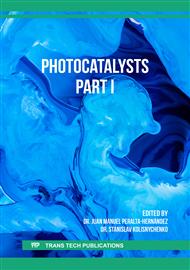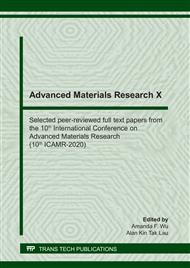[1]
U.I. Gaya, A.H. Abdullah, Heterogeneous photocatalytic degradation of organic contaminants over titanium dioxides: a review of fundamentals, process and problems, J.photochem.photobiol.C9(2008)1-12.
Google Scholar
[2]
M.A. Henderson. A surface science perspective on TiO2 photocatalysis, Surf.Sci.Rep. 66(2011)185-297.
Google Scholar
[3]
X.Q. Cheng, C.Y.Ma, X.Y.Yi, F.Yuan, Y.Xie, J.M.Hu, B.C.Hu, Q.Y. Zhang, Structural, morphological, optical and photocatalytic properties of Gd-doped TiO2 films, Thin Solid Films 615(2016) 13-18.
DOI: 10.1016/j.tsf.2016.06.049
Google Scholar
[4]
K.Sridharan, E.Jang, T.J. Park, Novel visible light active graphitic C3N4-TiO2 composite photocatalyst: Synergistic synthesis, growth and photocatalytic treatment of hazardous pollutants, Appl.Cata.B 142-143 (2013) 718-728.
DOI: 10.1016/j.apcatb.2013.05.077
Google Scholar
[5]
S.K. Choi, H.S. Yang, J.H. Kim, H.Park, Organic dye-sensitized TiO2 as a versatile photocatalyst for solar hydrogen and environmental remediation,Appl.Catal.B 121-122(2012)206-213.
DOI: 10.1016/j.apcatb.2012.04.011
Google Scholar
[6]
C.Quinones, J.Ayala, W.Vallejo, Methylene blue photoelectrodegradation under UV irradition on Au/Pd-modified TiO2 films, Appl. Surf. Sci. 257(2010) 367-371.
DOI: 10.1016/j.apsusc.2010.06.079
Google Scholar
[7]
S.Demirci, T. Dikici, M.Yurddaskal, S.Gultekin, M.Toparli, E.Celik, Synthesis and characterization of Ag doped TiO2 heterojunction films and their photocatalytic performances, Appl. Surf. Sci. 390(2016) 591-601.
DOI: 10.1016/j.apsusc.2016.08.145
Google Scholar
[8]
J.Wang, D.N. Tafen, J.P. Lewis, Z.L. Hong, A.Manivannan, M.J. Zhi, M.Li, N.Q.Wu, Origin of photocatalytic activity of nitrogen-doped TiO2 nanobelts, J.Am.Chem.Soc.131(2009) 12290-12297.
DOI: 10.1021/ja903781h
Google Scholar
[9]
A.T. Kuvarega, R.W.M. Krause, B.B. Mamba, Nitrogen/Palladium-codoped TiO2 for efficient visible light photocatalytic dye degradation, J.Phys.Chem. C115(2011) 22110-22120.
DOI: 10.1021/jp203754j
Google Scholar
[10]
R.A. Spurr, H.Myers, Quantitative analysis of anatase-rutile mixture with an x-ray diffractometer, Anal.Chem.29(1957)760-762.
DOI: 10.1021/ac60125a006
Google Scholar
[11]
D.H. Wang, L.Jia, X.L.Wu, L.Q.Lu, A.W.Xu, One-step hydrothermal synthesis of N-doped TiO2/C nanocomposites with high visible light photocatalytic activity, Nanoscale 4(2012) 576-584.
DOI: 10.1039/c1nr11353d
Google Scholar
[12]
N.D. Abazovic M.I. Comor M.D. Dramicanin, D.J. Jovanovic, S.P. Ahrenkiel, J.M. Nedeljkovic, Photoluminescence of anatase and rutile TiO2 particles, J.Phys.Chem. B110(2006) 25366-25370.
Google Scholar
[13]
L.Kernazhitsky, V.Shymanovska, T.Gavrilko, V.Naumov, L.Fedorenko, V.Kshnyakin, J.Baran, Room temperature photoluminescence of anatase and rutile TiO2 powders, J.Lumin. 146(2014) 199-204.
DOI: 10.1016/j.jlumin.2013.09.068
Google Scholar
[14]
X.Y. Pan, M.Q. Yang, X.Z.Fu, N.Zhang, Y.J.Xu, Defective TiO2 with oxygen vacancies: synthesis, properties and photocatalytic applications, Nanoscale 5(2013) 3601-3604.
DOI: 10.1039/c3nr00476g
Google Scholar
[15]
N.Daude, C.Gout, C.Jouanin, Electronic band structure of titanium dioxide, Phys.Rev.B15 (1977) 3229-3235.
DOI: 10.1103/physrevb.15.3229
Google Scholar



